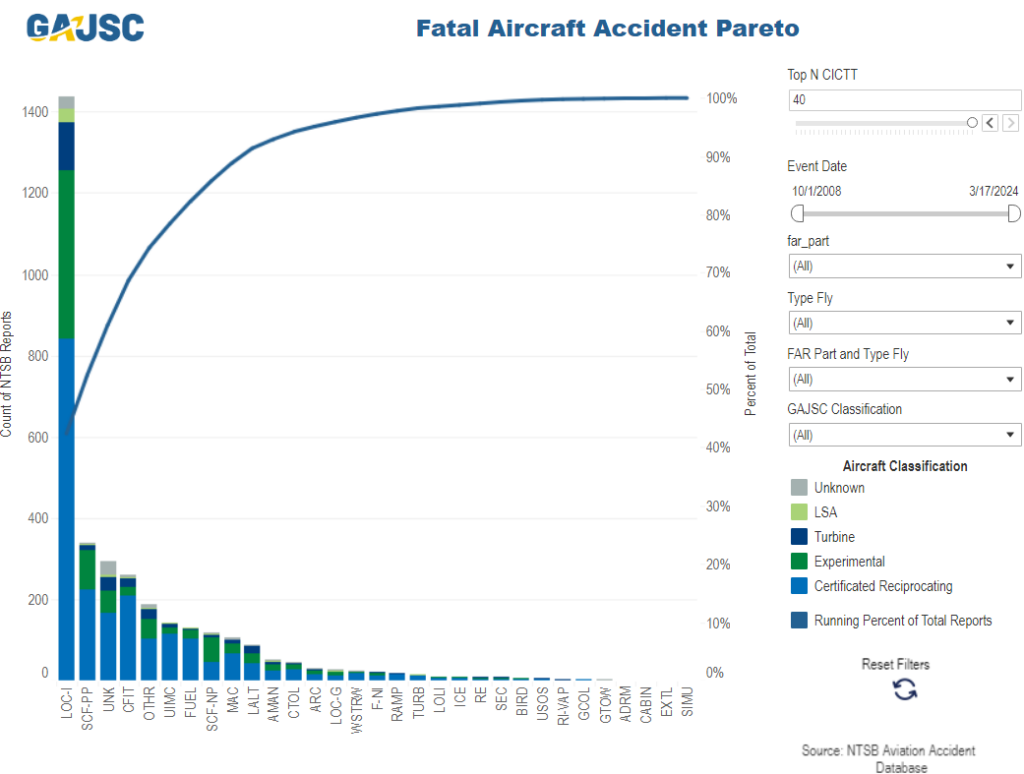This is the official document library of the GAJSC.
Working Group Reports:
- Controlled Flight Into Terrain (CFIT) Report: June 2021
- CFIT Report Appendix with Safety Enhancements: June 2011
- System Component Failure – Powerplant Report: June 2016
- Loss of Control on Approach and Landing and Departure and Enroute Report: October 2014
- Loss of Control on Approach and Landing: September 2012
Other Reports:
- SE-33 Safety Culture Working Group Final Report: June 2023
- Incorrect Surfaces Study: October 2023
- USHST & ASIAS Data Analysis Tools for Rotorcraft Operators: July 2022
- USHST & ASIAS Data Analysis Tools for Airplane Operators: July 2022
- Midair Collision Report: February 2022
- COVID Best Practices: October 2021
- Crashworthiness and Survivability Report: October 2017
- GA Safety Performance for FY2017 Report: October 2017
- GAJSC Safety Enhancement 41 Survivability Final Report: October 2017
- GAJSC Safety Enhancement 41 Survivability Final Report: October 2017
- GA Safety Performance for FY2016 Report: January 2016
- AeroSafety World: Datasharing: October 2015
- Mitre Project Story: General Aviation Pilots Get Their GAARD Up with New App: August 2015
- Streamlining Equipment Installation Detailed Intervention Implementation Plan: March 2014
- GA Aeronautical Decision-making Report: October 2002
- GADIT Accident-Data Task Report: August 2002
- GADIT Accident-Date Task Report: June 2001
- Runway Incursion Joint Safety Analysis Team (JSAT) Results & Analysis: August 2000
- Runway Incursion Joint Safety Analysis Team (JSAT) Results & Analysis Report: August 2000
- Weather Analysis Report: March 2000
- CFIT Analysis Report: February 2000
- Memo: GA Safety Metric and Goat for Post-FY2018: August 2017
- Aviation Safety Information Analysis and Sharing Project Demonstration for GA Recommendations: December 2015
- FAA Memo: Update Handbooks to Include AoA Indicator Info: December 2014
- FAA Memo: Approval of Non-Required Angle of Attack (AoA) Indicator Systems: February 2014
- Letter to Pilots: Impairing Medications (SE-15): July 2013
- Letter to Pilots: Impairing Medications (SE-15): July 2013
No docs at this time.
As part of Safer Skies, launched in 1998, the Federal Aviation Administration (FAA) and the general aviation (GA) community jointly developed a goal of reducing GA fatal accidents. The General Aviation Joint Safety Committee (GAJSC) uses a data-driven, consensus-based approach to analyze safety data to develop specific interventions that will mitigate the root causes of accidents. The GAJSC focuses on proactively assessing data to identifying new emerging issues and threats to general aviation safety, analyze them, and develop mitigation strategies to address and prioritize safety issues to prevent accidents.
Our brand is the public’s perception of who we are. That perception is the culmination of every experience and engagement they have with the General Aviation Joint Safety Committee (GAJSC). By reinforcing the GAJSC brand, the FAA, partner organizations, and aviators alike will come to know and relate to who we are with what we represent—creating a strong brand.
Understanding the GAJSC brand helps establish a clear and consistent voice and assists in developing effective content and collateral materials. This brand guide provides an overview of the brand and its styles and serves as a guide for use and implementation of the brand’s identity system.
The brand assets file below is password-protected. To request access, please send an email to [email protected].

